Backgrounder
How ‘Chinese’ are China’s Muslims? Islam in China: An Overview
An overview of Islam in China and China’s relation to its Muslim minority.
Published
10 years agoon

WHAT’S ON WEIBO ARCHIVE | PREMIUM CONTENT ARTICLE
As Muslim extremist attacks have ignited discussions on Islam in Europe, Chinese leaders increasingly expand restrictions on the Muslims within their borders. What’s on Weibo brings you an overview of Islam in China and China’s relation to its Muslim minorities.
The January attacks on the headquarters of Charlie Hebdo and a kosher supermarket in Paris by Muslim extremists have ignited heated discussions on radical Islam across Europe. From a distance, Chinese leaders watch Europe’s Islam debate and increasingly expand restrictions on the Muslims within their borders. Since this month, the burqa is banned, along with other garments that ‘promote religious extremist ideology’. “They see themselves as Muslim, we see them as Chinese,” says one Weibo netizen. What is the connection between Islam and China? What’s on Weibo brings you an overview of Islam in China and China’s relation to its Muslim minorities.
French Muslims: not ‘French’ enough?
After the Charlie Hebdo attacks, French Prime Minister Manuel Valls declared that France was now at war with “radical Islamism” (Economist 2015). In France, and Europe at large, hard questions have been emerging on Islam-inspired terrorism and the recruitment of people within European countries by radical groups such as Al-Qaeda and ISIS. France has the biggest Muslim minority in Europe, and the country’s relationship with them is not easy (Economist/Colchester 2015, 215). In response to the extremist attacks, U.S. President Obama stated that Europe has failed to integrate its Muslims (Francis 2015). About the U.S. he says: “Our biggest advantage is that our Muslim populations, they feel themselves to be Americans.” Europe has not had the same process of assimilation and immigration, according to Obama, suggesting that the identification of Muslims with their nation is crucial in combating radical Islam: French Muslims are simply not ‘French’ enough.
As Chinese President Xi Jinping expressed his sympathy for the victims of the Paris attacks, he said that terrorism was also an enemy to the People’s Republic of China (PRC) (SCMP 2015). China has a history of extremist terrorist attacks, linked to its Uyghur Muslim minority. What is the situation on Muslim integration in China? How ‘Chinese’ are China’s Muslims?
Islam in China: an overview
No burqa in Urumqi, no fasting for Ramadan, no niqabs, hijabs or large beards in buses. Since 2014, China has implemented several measures to keep religious expressions to a minimum after a string of attacks allegedly committed by Chinese Muslim extremists. In March 2014, a knife attack at the Kunming railway station left 29 civilians dead. In May, 43 were killed when a Urumqi market was bombed. On June 22, attackers drove into a Kashgar police building and set off explosives. The list continues. The government responded to the increasing violence in 2014 with a crackdown that resulted in more than 380 arrests within one month and public controls on religious expression (Tang 2014). The restrictions continued in 2015, when a ban on wearing burqa’s, or ‘face masking veils’ (面罩袍), was legally approved and went into effect on February 1st. The prohibition on burqa’s and other clothing ‘promoting religious extremism’ applies specifically to Urumqi, the capital of Xinjiang, which is home to the majority of China’s Muslims.
Few people in the West are aware of China’s large Muslim community. Yet Muslims are part of China’s history: they have lived in China from as early as the eighth century (Lipman 1997, xvii). Many Muslims came to China as soldiers, giving military aid to the Tang dynasty government during a rebellion uprise and then settling down afterwards. They also came as traders and diplomats along the Silk Road, setting up compact communities that maintained their own religion and lifestyle. Since intercultural marriages with local Chinese often occurred, the Muslim population increased, as non-Muslims had to convert to Islam before marrying (Mi & You 2004, 3-7). Although Muslims live all over China, the majority lives in the northwestern regions of Xinjiang, Ningxia, Gansu and the Qinghai provinces.
Is there such a thing as a ‘Chinese Muslim’? Within the PRC, Muslims are not defined as a specific category. Chinese citizens are divided into 56 different ‘minzu’ or ethnic groups; a categorization that is separated from religion. The vast majority of Chinese belong to the ‘Han’, which is considered a ‘culturally Chinese’ group. Within the other 55 minzu, there are ten that take Islam as their faith: the Huis, Uyghurs, Kazaks, Dongxiangs, Khalkas, Salas, Tajiks, Uzbeks, Bao’ans and Tatars (Mi & You 2004). About half of China’s Muslims belong to the Hui, the ethnic minority that descents from the foreign Muslims of the Tang (Lipman 1997, xxiii).
The northwestern region of Xinjiang is almost entirely Muslim, and was only joined by non-Muslims since the last fifty years. Of the 20 million-something people who live there, around eight million belong to the Uyghur minority. Although there are no official government records of how many people practice Islam within the PRC, it is estimated that there are currently are around 23 million Muslims in China, a number that is expected to grow to almost 30 million in 2030 (Pew 2011).
China’s northwest has always been a region filled with unrest. While Muslim identity strengthened throughout the 17th and 18th century, other rulers (Arab, Mongols, Russians) were looking for new lands to expand their power in present-day Xinjiang. The situation reached a crisis point. In the 19th century, the Chinese Qing government ordered a suppression of Muslim rebels. It is estimated that 20 to 30 million lives were lost in this suppression (Jones-Leaning & Pratt 2012, 317). During the Mao years, Muslims in the northwestern regions suffered greatly from the Great Leap Forward and the Cultural Revolution (1966-1976), as the famine was especially severe in these provinces. Religious buildings and schools were destroyed by the Red Guards, Arabic script was prohibited, and Muslims were expected to rear pigs and eat pork (ibid., 318).
“Believe it, don’t show it”
After the Mao years, it was acknowledged that religious beliefs could not be completely abolished (ibid., 318). Freedom of religion was officially declared in 1949, but the Communist Party believed that theistic religion would ultimately disappear. Atheism was therefore propagated amongst the people. In current-day China, religion is more or less tolerated, as long as it conforms to state-approved principles and organization (Boyle & Sheen 2003, 179-180). Instead of guaranteeing free exercise of religion, the constitution only guarantees freedom of religious belief. In other words; you can believe what you want, but how you engage with your religion in everyday life has to comply with what the state deems right.
In the reform period of the 1980s, the PRC had a policy of cultural liberalization that also applied to China’s northwest. Mosques were reopened and religion was revived. But as extremist Islamic movements expanded internationally, radical groups mushroomed in China’s northwest. Muslim separatist groups called for Xinjiang to form an independent East Turkestan state. Especially after September 11, Chinese authorities focused on its northwest, that had by now become its most politically sensitive region – Western media were also watching the “Islamic terrorism” in Xinjiang (Dwyer 2005, 3). For the last decades, Beijing has been propagating Chinese monoculturalism, trying to assimilate the major minorities of the northwest (especially the Uyghurs) to the dominant Chinese culture (ibid., 2).
Amnesty International has reported harsh measures taken by Chinese authorities to suppress unrest in the northwest, including executions and unfair trials (Jones-Leaning & Pratt 2012, 328). “The fight against terrorism is no excuse for repression,” says Amnesty. In its crackdown on terrorism, the government has introduced several policies, including those on language: they prioritize Chinese language before minority language. It also also closed several mosques and islamic schools because of “anti-Chinese activity” (ibid., 328). Ramadan has been officially discouraged, religious dress restricted, and media freedom constrained.
How ‘Chinese’ are China’s Muslims?
The burqa ban has stirred online discussions on what does and does not belong to the identity of China’s Muslims. “I fully support the ban on face-covering veils,” says one netizen: “Uyghurs can wear authentic Uyghur clothing, but the black veil definitely is not part of it – it belongs to terrorism.” Another netizen agrees: “The burqa is part of an evil cult, and has no place within the Uyghur community.”
Although there definitely are various traditional styles of clothing within the different Muslim communities of China, their clothing also follow the Quran’s instructions on moderate dress. Women in some parts of Xinjiang are expected to cover their heads and faces (ibid., 327). Chinese authorities have been trying to root out orthodox Islam wear within Muslim minorities by launching the ‘Beauty Project‘ (靓丽工程), discouraging men to grow beards and women to wear veils.
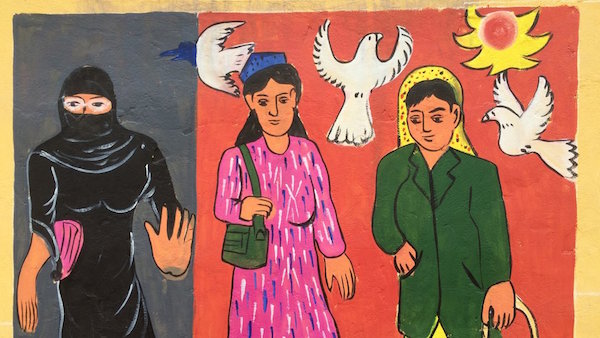 Propaganda murals painted next to a mosque in Kashgar, Xinjiang, showing what the Chinese government deems as acceptable (BBC 2015).
Propaganda murals painted next to a mosque in Kashgar, Xinjiang, showing what the Chinese government deems as acceptable (BBC 2015).
“They identify themselves through their religion,” says a Weibo user about Chinese Muslims: “They only identify themselves with Islam. But we identify them as Chinese.” Is this the key to the problem of China’s relations with its Muslims? Does the majority of China really see their Muslim minorities as ‘Chinese’? Do the Muslim minorities see themselves only as ‘Muslim’? The truth probably lies in the middle, and relates to problematic questions on what it means to be ‘Chinese’ or what identifies a ‘Muslim’ in China.
The fact is that Muslims are part of modern-day China. It is their motherland; the only home they have ever known. Yet they are still working to make a place for themselves. Historically, they are more ‘Chinese’ than America’s Muslims are ‘American’. Culturally, they are less ‘Chinese’ than the Muslims of France are ‘French’.
The wider problem remains; China’s relations to its Muslim minorities in the northwest has no sign of progress. Meanwhile, Islam-related terrorist attacks continue. Not enough integration? Too much suppression? China’s government, propagating monoculturalism, does not hold the key to the Islam problem. Nor do European leaders, who have advocated multiculturalism. Obama emphasises the importance of Muslim integration, but it needs two things in order to be successful: a free society that protects faith, and a faith that protects free society. Unfortunately, there is still a long road ahead.
– by Manya Koetse
Did you know…?
* The majority of China’s muslims are orthodox Sunni Muslim.
* The oldest mosque of China is the Great Mosque of Xi’an from 742, covering 130,000 square meters.
* Before 1884, present-day Xinjiang was divided in a northern part (Dzugaria) and southern part (Tarim Basim). It was designated as Xinjiang Uyghur Autonomous Region in 1955.
* Xinjiang borders on eight different countries: Afghanistan, Pakistan, India, Mongolia, Russia, Kazakstan, Kyrgystan and Tajikistan.
* Xinjiang literally means ‘new border’ in Chinese.
* Beijing has 40 mosques, whereas Kashgar currently has over 6000, which is only half of the number prior to the Cultural Revolution.
*China’s Hui Muslim minority has a long cultural tradition of female imams. There are hundreds of female imams leading mosques around the country.
References
Abe, Tetsuya. 2015. “Living with terror: China clamps down on Uighurs after Paris attacks.” Nikkei Asian Review, 15 January http://asia.nikkei.com/magazine/20150115-Living-with-terror/Politics-Economy/Living-with-terror-China-clamps-down-on-Uighurs-after-Paris-attacks [17.1.15].
BBC. 2015. “The Colorful Propaganda of Xijiang.” BBC News, January 15 http://www.bbc.com/news/world-asia-china-30722268 [17.1.15].
Boyle, Kevin and Juliet Sheen. 2003 (1997). Freedom of Religion and Belief: A World Report. London: Routledge.
Cartillier, Jerome. 2015. “Obama: Europe should better integrate Muslims.” Yahoo News, 16
January http://news.yahoo.com/us-britain-vow-help-france-paris-attacks-obama-
175747690.html [18.1.15].
Colchester, Max. 2015. “France Mulls Deep-Rooted Problems Behind Attacks.” Wall Street
Journal, 9 January http://www.wsj.com/articles/france-mulls-deep-rooted-problems-behind-attacks-
1420824161 [17.1.15].
Dwyer, Arienne M. 2005. “The Xinjiang Conflict: Uyghur Identity, Language Policy, and Political Discourse.” Policy Studies: 15.
Economist. 2015. “Terror and Islam: After the Atrocities.” Economist, 17 January
http://www.economist.com/news/briefing/21639540-attacks-charlie-hebdo-and-kosher-supermarket-brought-french-together-unity [17.1.15].
Francis, David. 2015. “Obama Slaps Europe for Failing to Integrate Muslims.” Foreign
Policy, 16 January http://foreignpolicy.com/2015/01/16/obama-slaps-europe-for-failing-to-
integrate-muslims/ [18.1.15].
Jones-Leaning, Melanie and Douglas Pratt. 2012. “Islam in China, From Silk Road to Separatism.” Muslim World 102: 308-334.
Koetse, Manya. 2015. “Chinese reacties op de aanslag op Charlie Hebdo.” 360 Magazine, 15
January http://www.360magazine.nl/politiek/4274/chinese-reacties-op-de-aanslag-op-charlie-
hebdo#.VLvM-YrF_xg [18.1.15].
Lipman, Jonathan. 1997. Familiar Strangers, A History of Muslims in Northwest China. Washington: University of Washington Press.
Mi, Shoujiang and Jia You (translated by Min Chang). 2004. Islam in China. Beijing: China Intercontinental Press.
Pew 2011. “The Future of the Global Muslim Population.” Pew Research Center, January 27
http://www.pewforum.org/2011/01/27/the-future-of-the-global-muslim-population/ [18.1.15].
SCMP. 2015. “France mourns victims in Charlie Hebdo attack as police hunt gunmen.” South
China Morning Post, 9 January http://www.scmp.com/news/world/article/1677755/france-mourns-
police-hunt-charlie-hebdo-gunmen [18.1.15].
Tang, Didi. 2014. “China Bans Ramadan Fast In Schools.” The Huffington Post. June 2 http://www.huffingtonpost.com/2014/07/02/china-bans-ramadan_n_5551063.html [11.2.15]
Images
http://d.ibtimes.co.uk/en/full/1392110/xinjiang.jpg
http://www.bbc.com/news/world-asia-china-30722268
http://www.scmp.com/news/china/article/1567483/xinjiang-city-bans-muslim-clothing-and-large-beards-public-buses?page=all
©2014 Whatsonweibo. All rights reserved. Do not reproduce our content without permission – you can contact us at info@whatsonweibo.com.
Manya is the founder and editor-in-chief of What's on Weibo, offering independent analysis of social trends, online media, and digital culture in China for over a decade. Subscribe to gain access to content, including the Weibo Watch newsletter, which provides deeper insights into the China trends that matter. More about Manya at manyakoetse.com or follow on X.

Backgrounder
“Oppenheimer” in China: Highlighting the Story of Qian Xuesen
Qian Xuesen is a renowned Chinese scientist whose life shares remarkable parallels with Oppenheimer’s.
Published
2 years agoon
September 16, 2023By
Zilan Qian
They shared the same campus, lived in the same era, and both played pivotal roles in shaping modern history while navigating the intricate interplay between science and politics. With the release of the “Oppenheimer” movie in China, the renowned Chinese scientist Qian Xuesen is being compared to the American J. Robert Oppenheimer.
In late August, the highly anticipated U.S. movie Oppenheimer finally premiered in China, shedding light on the life of the famous American theoretical physicist J. Robert Oppenheimer (1904-1967).
Besides igniting discussions about the life of this prominent scientist, the film has also reignited domestic media and public interest in Chinese scientists connected to Oppenheimer and nuclear physics.
There is one Chinese scientist whose life shares remarkable parallels with Oppenheimer’s. This is aerospace engineer and cyberneticist Qian Xuesen (钱学森, 1911-2009). Like Oppenheimer, he pursued his postgraduate studies overseas, taught at Caltech, and played a pivotal role during World War II for the US.
Qian Xuesen is so widely recognized in China that whenever I introduce myself there, I often clarify my last name by saying, “it’s the same Qian as Qian Xuesen’s,” to ensure that people get my name.
Some Chinese blogs recently compared the academic paths and scholarly contributions of the two scientists, while others highlighted the similarities in their political challenges, including the revocation of their security clearances.
The era of McCarthyism in the United States cast a shadow over Qian’s career, and, similar to Oppenheimer, he was branded as a “communist suspect.” Eventually, these political pressures forced him to return to China.
Although Qian’s return to China made his later life different from Oppenheimer’s, both scientists lived their lives navigating the complex dynamics between science and politics. Here, we provide a brief overview of the life and accomplishments of Qian Xuesen.
Departing: Going to America
Qian Xuesen (钱学森, also written as Hsue-Shen Tsien), often referred to as the “father of China’s missile and space program,” was born in Shanghai in 1911,1 a pivotal year marked by a historic revolution that brought an end to the imperial dynasty and gave rise to the Republic of China.
Much like Oppenheimer, who pursued further studies at Cambridge after completing his undergraduate education, Qian embarked on a journey to the United States following his bachelor’s studies at National Chiao Tung University (now Shanghai Jiao Tong University). He spent a year at Tsinghua University in preparation for his departure.
The year was 1935, during the eighth year of the Chinese Civil War and the fourth year of Japan’s invasion of China, setting the backdrop for his academic pursuits in a turbulent era.
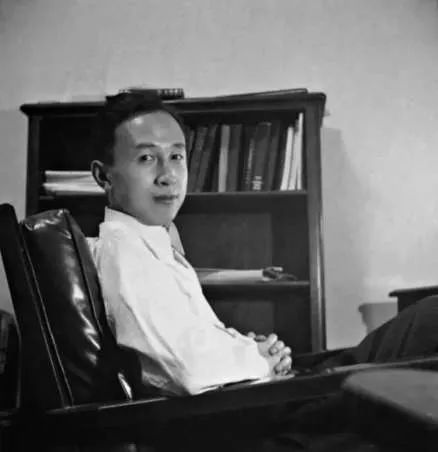
Qian in his office at Caltech (image source).
One year after arriving in the U.S., Qian earned his master’s degree in aeronautical engineering from the Massachusetts Institute of Technology (MIT). Three years later, in 1939, the 27-year-old Qian Xuesen completed his PhD at the California Institute of Technology (Caltech), the very institution where Oppenheimer had been welcomed in 1927. In 1943, Qian solidified his position in academia as an associate professor at Caltech. While at Caltech, Qian helped found NASA’s Jet Propulsion Laboratory.
When World War II began, while Oppenheimer was overseeing the Manhattan Project’s efforts to assist the U.S. in developing the atomic bomb, Qian actively supported the U.S. government. He served on the U.S. government’s Scientific Advisory Board and attained the rank of lieutenant colonel.

The first meeting of the US Department of the Air Force Scientific Advisory Board in 1946. The predecessor, the Scientific Advisory Group, was founded in 1944 to evaluate the aeronautical programs and facilities of the Axis powers of World War II. Qian can be seen standing in the back, the second on the left (image source).
After the war, Qian went to teach at MIT and returned to Caltech as a full-time professor in 1949. During that same year, Mao Zedong proclaimed the establishment of the People’s Republic of China (PRC). Just one year later, the newly-formed nation became involved in the Korean War, and China fought a bloody battle against the United States.
Red Scare: Being Labeled as a Communist
Robert Oppenheimer and Qian Xuesen both had an interest in Communism even prior to World War II, attending communist gatherings and showing sympathy towards the Communist cause.
Qian and Oppenheimer may have briefly met each other through their shared involvement in communist activities. During his time at Caltech, Qian secretly attended meetings with Frank Oppenheimer, the brother of J. Robert Oppenheimer (Monk 2013).
However, it was only after the war that their political leanings became a focal point for the FBI.
Just as the FBI accused Oppenheimer of being an agent of the Soviet Union, they quickly labeled Qian as a subversive communist, largely due to his Chinese heritage. While the government did not succeed in proving that Qian had communist ties with China during that period, they did ultimately succeed in portraying Qian as a communist affiliated with China a decade later.
During the transition from the 1940s to the 1950s, the Cold War was underway, and the anti-communist witch-hunts associated with the McCarthy era started to intensify (BBC 2020).
In 1950, the Korean War erupted, with the People’s Republic of China (PRC) joining North Korea in the conflict against South Korea, which received support from the United States. It was during this tumultuous period that the FBI officially accused Qian of communist sympathies in 1950, leading to the revocation of his security clearance despite objections from Qian’s colleagues. Four years later, in 1954, Robert Oppenheimer went through a similar process.
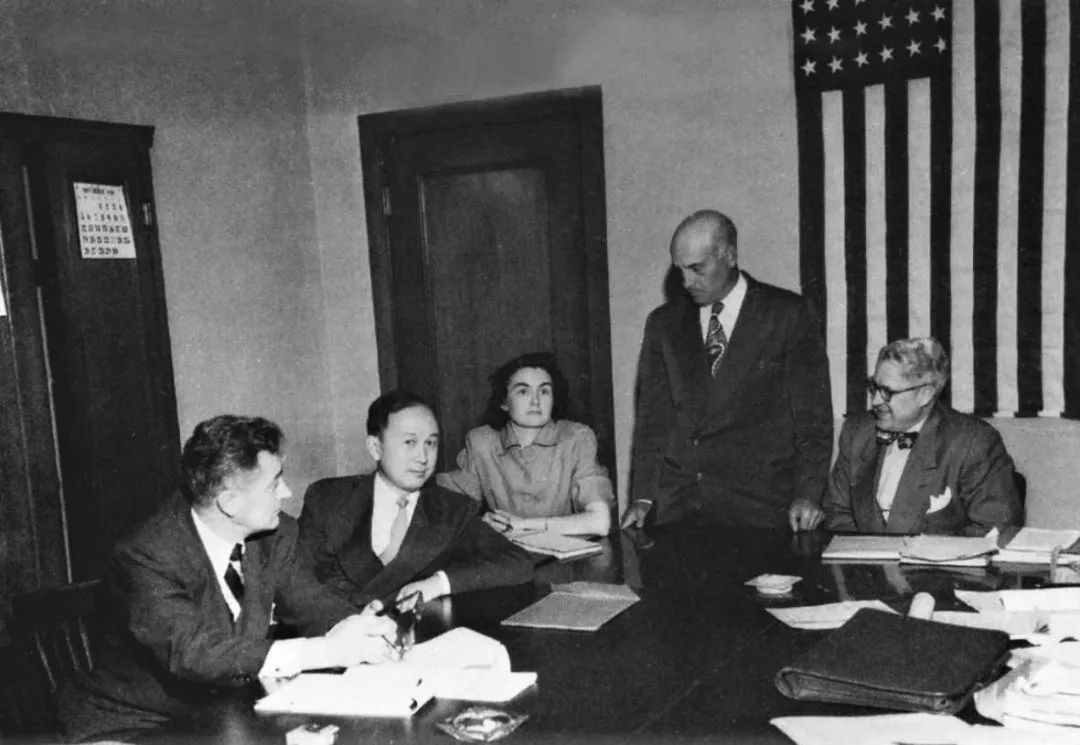
The 1950’s security hearing of Qian (second left). (Image source).
After losing his security clearance, Qian began to pack up, saying he wanted to visit his aging parents back home. Federal agents seized his luggage, which they claimed contained classified materials, and arrested him on suspicion of subversive activity. Although Qian denied any Communist leanings and rejected the accusation, he was detained by the government in California and spent the next five years under house arrest.
Five years later, in 1955, two years after the end of the Korean War, Qian was sent home to China as part of an apparent exchange for 11 American airmen who had been captured during the war. He told waiting reporters he “would never step foot in America again,” and he kept his promise (BBC 2020).
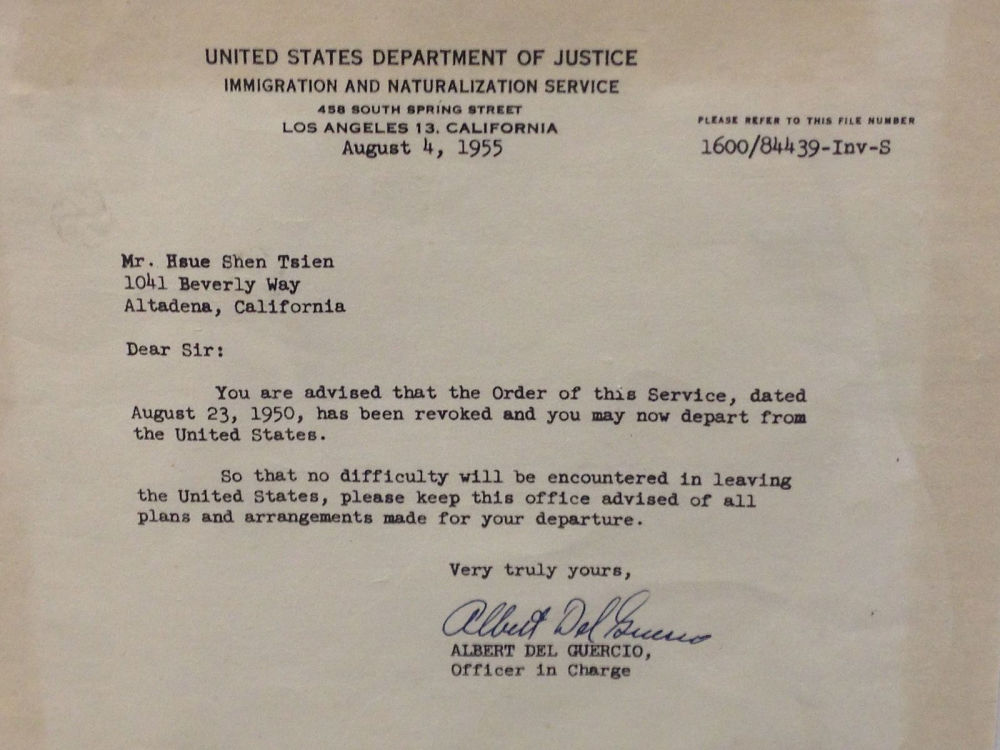
A letter from the US Immigration and Naturalization Service to Qian Xuesen, dated August 4, 1955, in which he was notified he was allowed to leave the US. The original copy is owned by Qian Xuesen Library of Shanghai Jiao Tong University, where the photo was taken. (Caption and image via wiki).
Dan Kimball, who was the Secretary of the US Navy at the time, expressed his regret about Qian’s departure, reportedly stating, “I’d rather shoot him dead than let him leave America. Wherever he goes, he equals five divisions.” He also stated: “It was the stupidest thing this country ever did. He was no more a communist than I was, and we forced him to go” (Perrett & Bradley, 2008).
Kimball may have foreseen the unfolding events accurately. After his return to China, Qian did indeed assume a pivotal role in enhancing China’s military capabilities, possibly surpassing the potency of five divisions. The missile programme that Qian helped develop in China resulted in weapons which were then fired back on America, including during the 1991 Gulf War (BBC 2020).
Returning: Becoming a National Hero
The China that Qian Xuesen had left behind was an entirely different China than the one he returned to. China, although having relatively few experts in the field, was embracing new possibilities and technologies related to rocketry and space exploration.
Within less than a month of his arrival, Qian was welcomed by the then Vice Prime Minister Chen Yi, and just four months later, he had the honor of meeting Chairman Mao himself.
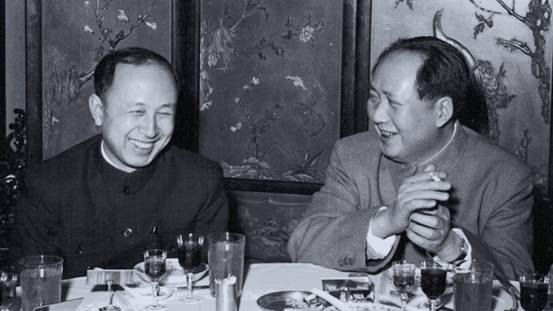
Qian and Mao (image source).
In China, Qian began a remarkably successful career in rocket science, with great support from the state. He not only assumed leadership but also earned the distinguished title of the “father” of the Chinese missile program, instrumental in equipping China with Dongfeng ballistic missiles, Silkworm anti-ship missiles, and Long March space rockets.
Additionally, his efforts laid the foundation for China’s contemporary surveillance system.
By now, Qian has become somewhat of a folk hero. His tale of returning to China despite being thwarted by the U.S. government has become like a legendary narrative in China: driven by unwavering patriotism, he willingly abandoned his overseas success, surmounted formidable challenges, and dedicated himself to his motherland.
Throughout his lifetime, Qian received numerous state medals in recognition of his work, establishing him as a nationally celebrated intellectual. From 1989 to 2001, the state-launched public movement “Learn from Qian Xuesen” was promoted throughout the country, and by 2001, when Qian turned 90, the national praise for him was on a similar level as that for Deng Xiaoping in the decade prior (Wang 2011).
Qian Xuesen remains a celebrated figure. On September 3rd of this year, a new “Qian Xuesen School” was established in Wenzhou, Zhejiang Province, becoming the sixth high school bearing the scientist’s name since the founding of the first one only a year ago.
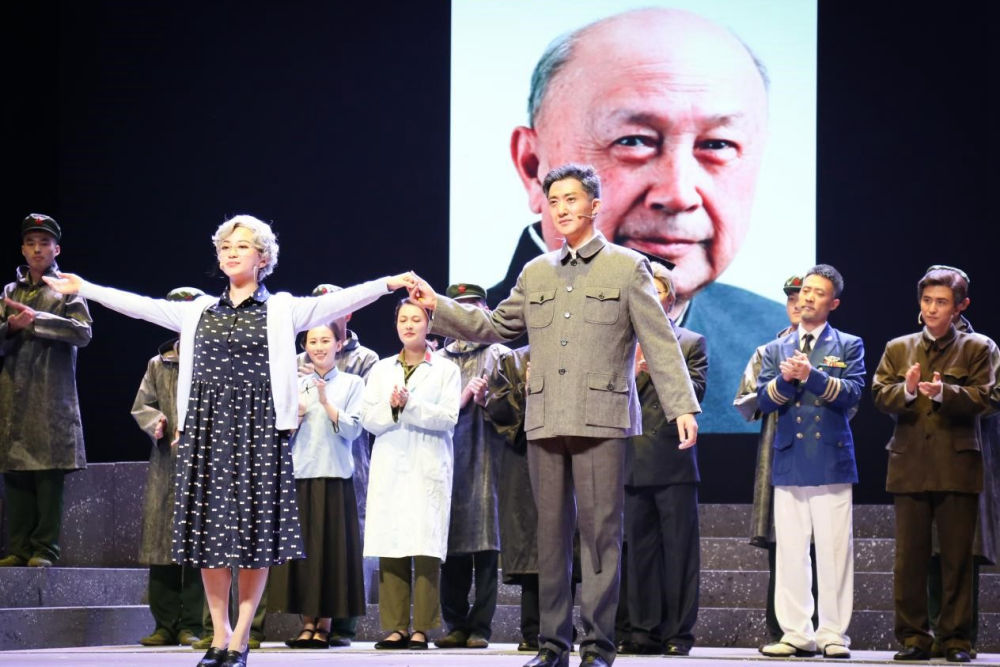
In 2017, the play “Qian Xuesen” was performed at Qian’s alma mater, Shanghai Jiaotong University. (Image source.)
Qian Xuesen’s legacy extends well beyond educational institutions. His name frequently appears in the media, including online articles, books, and other publications. There is the Qian Xuesen Library and a museum in Shanghai, containing over 70,000 artefacts related to him. Qian’s life story has also been the inspiration for a theater production and a 2012 movie titled Hsue-Shen Tsien (钱学森).2
Unanswered Questions
As is often the case when people are turned into heroes, some part of the stories are left behind while others are highlighted. This holds true for both Robert Oppenheimer and Qian Xuesen.
The Communist Party of China hailed Qian as a folk hero, aligning with their vision of a strong, patriotic nation. Many Chinese narratives avoid the debate over whether Qian’s return was linked to problems and accusations in the U.S., rather than genuine loyalty to his homeland.
In contrast, some international media have depicted Qian as a “political opportunist” who returned to China due to disillusionment with the U.S., also highlighting his criticism of “revisionist” colleagues during the Cultural Revolution and his denunciation of the 1989 student demonstrations.
Unlike the image of a resolute loyalist favored by the Chinese public, Qian’s political ideology was, in fact, not consistently aligned, and there were instances where he may have prioritized opportunity over loyalty at different stages of his life.
Qian also did not necessarily aspire to be a “flawless hero.” Upon returning to China, he declined all offers to have his biography written for him and refrained from sharing personal information with the media. Consequently, very little is known about his personal life, leaving many questions about the motivations driving him, and his true political inclinations.
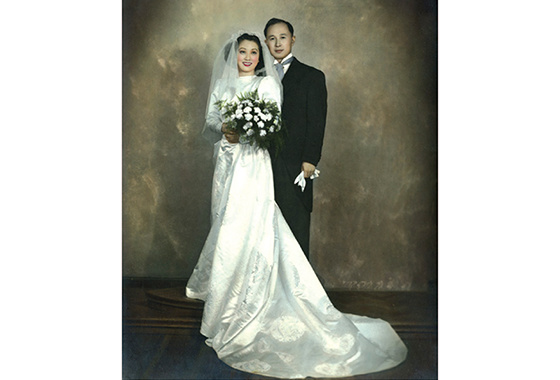
The marriage photo of Qian and Jiang. (Image source).
We do know that Qian’s wife, Jiang Ying (蒋英), had a remarkable background. She was of Chinese-Japanese mixed race and was the daughter of a prominent military strategist associated with Chiang Kai-shek. Jiang Ying was also an accomplished opera singer and later became a professor of music and opera at the Central Conservatory of Music in Beijing.
Just as with Qian, there remain numerous unanswered questions surrounding Oppenheimer, including the extent of his communist sympathies and whether these sympathies indirectly assisted the Soviet Union during the Cold War.
Perhaps both scientists never imagined they would face these questions when they first decided to study physics. After all, they were scientists, not the heroes that some narratives portray them to be.
Also read:
■ Farewell to a Self-Taught Master: Remembering China’s Colorful, Bold, and Iconic Artist Huang Yongyu
■ “His Name Was Mao Anying”: Renewed Remembrance of Mao Zedong’s Son on Chinese Social Media
By Zilan Qian
Follow @whatsonweibo
1 Some sources claim that Qian was born in Hangzhou, while others say he was born in Shanghai with ancestral roots in Hangzhou.
2The Chinese character 钱 is typically romanized as “Qian” in Pinyin. However, “Tsien” is a romanization in Wu Chinese, which corresponds to the dialect spoken in the region where Qian Xuesen and his family have ancestral roots.
This article has been edited for clarity by Manya Koetse
References (other sources hyperlinked in text)
BBC. 2020. “Qian Xuesen: The man the US deported – who then helped China into space.” BBC.com, 27 October https://www.bbc.com/news/stories-54695598 [9.16.23].
Monk, Ray. 2013. Robert Oppenheimer: A Life inside the Center, First American Edition. New York: Doubleday.
Perrett, Bradley, and James R. Asker. 2008. “Person of the Year: Qian Xuesen.” Aviation Week and Space Technology 168 (1): 57-61.
Wang, Ning. 2011. “The Making of an Intellectual Hero: Chinese Narratives of Qian Xuesen.” The China Quarterly, 206, 352-371. doi:10.1017/S0305741011000300
Get the story behind the hashtag. Subscribe to What’s on Weibo here to receive our newsletter and get access to our latest articles:
Spotted a mistake or want to add something? Please let us know in comments below or email us. First-time commenters, please be patient – we will have to manually approve your comment before it appears.
©2023 Whatsonweibo. All rights reserved. Do not reproduce our content without permission – you can contact us at info@whatsonweibo.com.
Backgrounder
Farewell to a Self-Taught Master: Remembering China’s Colorful, Bold, and Iconic Artist Huang Yongyu
Renowned Chinese artist and the creator of the ‘Blue Rabbit’ zodiac stamp Huang Yongyu has passed away at the age of 98. “I’m not afraid to die. If I’m dead, you may tickle me and see if I smile.”
Published
2 years agoon
June 15, 2023
The famous Chinese painter, satirical poet, and cartoonist Huang Yongyu has passed away. Born in 1924, Huang endured war and hardship, yet never lost his zest for life. When his creativity was hindered and his work was suppressed during politically tumultuous times, he remained resilient and increased “the fun of living” by making his world more colorful.
He was a youthful optimist at old age, and will now be remembered as an immortal legend. The renowned Chinese painter and stamp designer Huang Yongyu (黄永玉) passed away on June 13 at the age of 98. His departure garnered significant attention on Chinese social media platforms this week.
On Weibo, the hashtag “Huang Yongyu Passed Away” (#黄永玉逝世#) received over 160 million views by Wednesday evening.
Huang was a member of the China National Academy of Painting (中国国家画院) as well as a Professor at the Central Academy of Fine Arts (中央美术学院).
Huang Yongyu is widely recognized in China for his notable contribution to stamp design, particularly for his iconic creation of the monkey stamp in 1980. Although he designed a second monkey stamp in 2016, the 1980 stamp holds significant historical importance as it marked the commencement of China Post’s annual tradition of releasing zodiac stamps, which have since become highly regarded and collectible items.

Huang’s famous money stamp that was issued by China Post in 1980.
The monkey stamp designed by Huang Yongyu has become a cherished collector’s item, even outside of China. On online marketplaces like eBay, individual stamps from this series are being sold for approximately $2000 these days.
Huang Yongyu’s latest most famous stamp was this year’s China Post zodiac stamp. The stamp, a blue rabbit with red eyes, caused some online commotion as many people thought it looked “horrific.”
Some thought the red-eyed blue rabbit looked like a rat. Others thought it looked “evil” or “monster-like.” There were also those who wondered if the blue rabbit looked so wild because it just caught Covid.
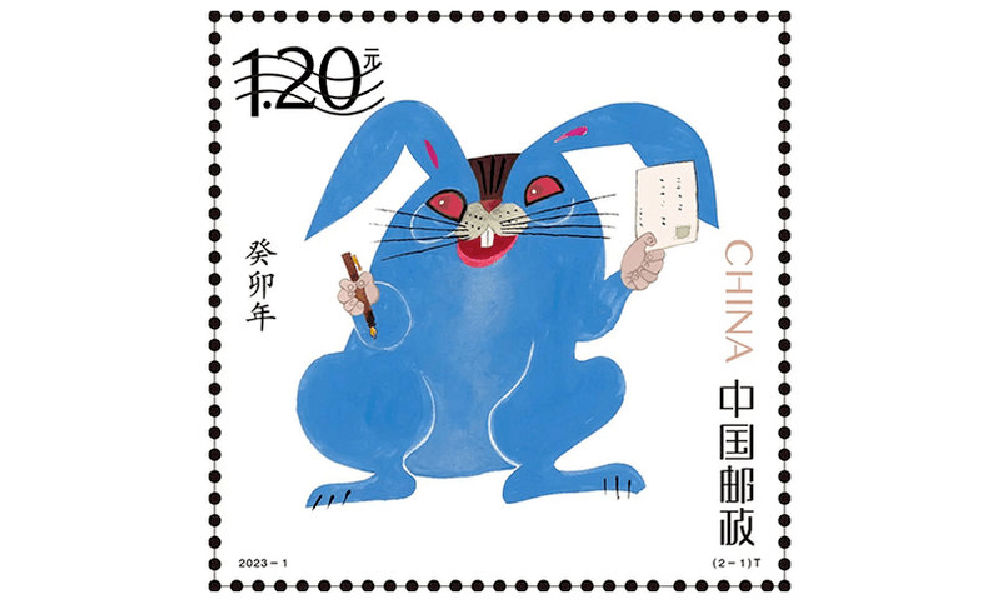
Huang’s (in)famous blue rabbit stamp.
Nevertheless, many people lined up at post offices for the stamps and they immediately sold out.
In light of the controversy, Huang Yongyu spoke about the stamps in a livestream in January of 2023. The 98-year-old artist claimed he had simply drawn the rabbit to spread joy and celebrate the new year, stating, “Painting a rabbit stamp is a happy thing. Everyone could draw my rabbit. It’s not like I’m the only one who can draw this.”
Huang’s response also went viral, with one Weibo hashtag dedicated to the topic receiving over 12 million views (#蓝兔邮票设计者直播回应争议#) at the time. Those defending Huang emphasized how it was precisely his playful, light, and unique approach to art that has made Huang’s work so famous.
A Self-Made Artist
“I’m ugly, but my mum likes me”
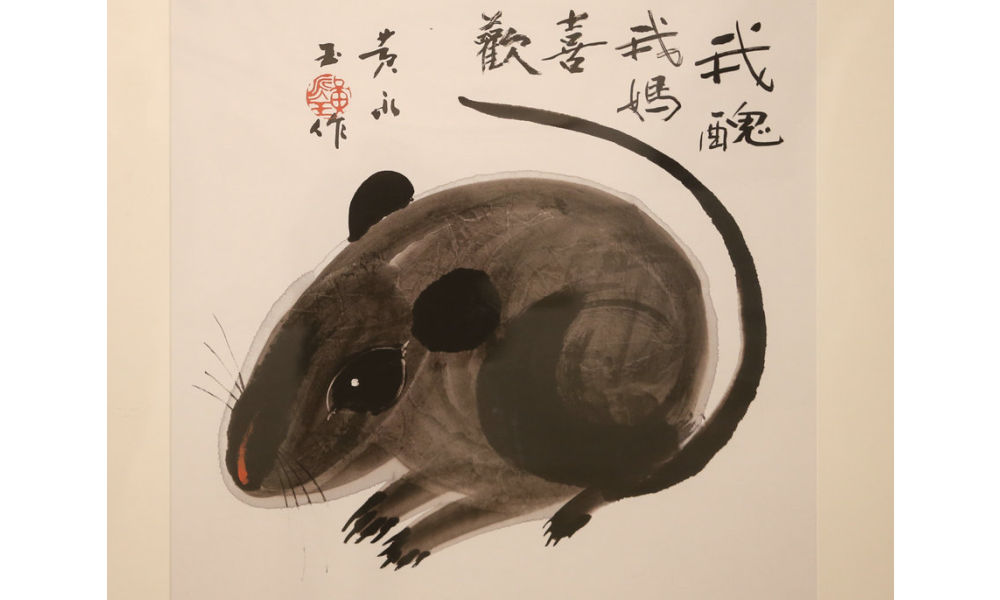
‘Ugly Mouse’ by Huang Yongyu [Image via China Daily].
Huang Yongyu was born on August 9, 1924, in Hunan’s Chengde as a native of the Tujia ethnic group.
He was born into an extraordinary family. His grandfather, Huang Jingming (黄镜铭), worked for Xiong Xiling (熊希齡), who would become the Premier of the Republic of China. His first cousin and lifelong friend was the famous Chinese novelist Shen Congwen (沈从文). Huang’s father studied music and art and was good at drawing and playing the accordion. His mother graduated from the Second Provincial Normal School and was the first woman in her county to cut her hair short and wear a short skirt (CCTV).
Born in times of unrest and poverty, Huang never went to college and was sent away to live with relatives at the age of 13. His father would die shortly after, depriving him of a final goodbye. Huang started working in various places and regions, from porcelain workshops in Dehua to artisans’ spaces in Quanzhou. At the age of 16, Huang was already earning a living as a painter and woodcutter, showcasing his talents and setting the foundation for his future artistic pursuits.
When he was 22, Huang married his first girlfriend Zhang Meixi (张梅溪), a general’s daughter, with whom he shared a love for animals. He confessed his love for her when they both found themselves in a bomb shelter after an air-raid alarm.

Huang and Zhang Meixi [163.com]
In his twenties, Huang Yongyu emerged as a sought-after artist in Hong Kong, where he had relocated in 1948 to evade persecution for his left-wing activities. Despite achieving success there, he heeded Shen Congwen’s advice in 1953 and moved to Beijing. Accompanied by his wife and their 7-month-old child, Huang took on a teaching position at the esteemed Central Academy of Fine Arts (中央美术学院).
The couple raised all kinds of animals at their Beijing home, from dogs and owls to turkeys and sika deers, and even monkeys and bears (Baike).
Throughout Huang’s career, animals played a significant role, not only reflecting his youthful spirit but also serving as vehicles for conveying satirical messages.
One recurring motif in his artwork was the incorporation of mice. In one of his famous works, a grey mouse is accompanied by the phrase ‘I’m ugly, but my mum likes me’ (‘我丑,但我妈喜欢’), reinforcing the notion that regardless of our outward appearance or circumstances, we remain beloved children in the eyes of our mothers.
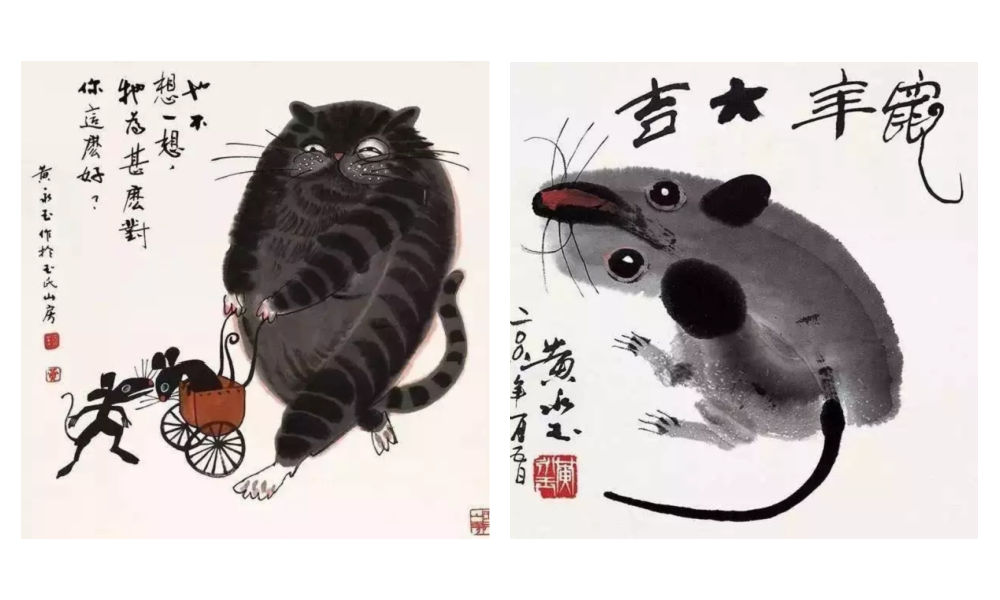
As a teacher, Huang liked to keep his lessons open-minded and he, who refused to join the Party himself, stressed the importance of art over politics. He would hold “no shirt parties” in which his all-male studio students would paint in an atmosphere of openness and camaraderie during hot summer nights (Andrews 1994, 221; Hawks 2017, 99).
By 1962, creativity in the classroom was limited and there were far more restrictions to what could and could not be created, said, and taught.
Bright Colors in Dark Times
“Strengthen my resolve and increase the fun of living”

Huang Yongyu’s winking owl, 1973, via Wikiart.
In 1963, Huang was sent to the countryside as part of the “Four Cleanups” movement (四清运动, 1963-1966). Although Huang cooperated with the requirement to attend political meetings and do farm work, he distanced himself from attempts to reform his thinking. In his own time, and even during political meetings, he would continue to compose satirical and humorous pictures and captions centered around animals, which would later turn into his ‘A Can of Worms’ series (Hawks 2017, 99; see Morningsun.org).
Three years later, at the beginning of the Cultural Revolution, many Chinese major artists, including Huang, were detained in makeshift jails called ‘niupeng‘ (牛棚), cowsheds. Huang’s work was declared to be counter-revolutionary, and he was denounced and severely beaten. Despite the difficult circumstances, Huang’s humor and kindness would remind his fellow artist prisoners of the joy of daily living (2017, 95-96).
After his release, Huang and his family were relocated to a cramped room on the outskirts of Beijing. The authorities, thinking they could thwart his artistic pursuits, provided him with a shed that had only one window, which faced a neighbor’s wall. However, this limitation didn’t deter Huang. Instead, he ingeniously utilized vibrant pigments that shone brightly even in the dimly lit space.
During this time, he also decided to make himself an “extra window” by creating an oil painting titled “Eternal Window” (永远的窗户). Huang later explained that the flower blossoms in the paining were also intended to “strengthen my resolve and increase the fun of living” (Hawks 2017, 4; 100-101).
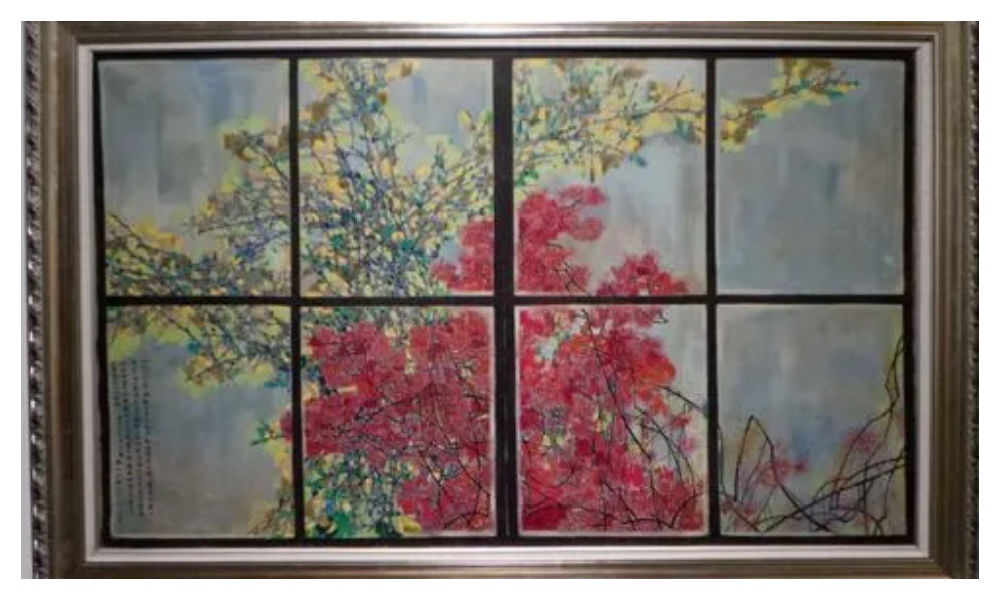
Huang Yongyu’s Eternal Window [Baidu].
In 1973, during the peak of the Cultural Revolution, Huang painted his famous winking owl. The calligraphy next to the owl reads: “During the day people curse me with vile words, but at night I work for them” (“白天人们用恶毒的语言诅咒我,夜晚我为他们工作”) (Matthysen 2021, 165).
The painting was seen as a display of animosity towards the regime, and Huang got in trouble for it. Later on in his career, however, Huang would continue to paint owls. In 1977, when the Cultural Revolution had ended, Huang Yongyu painted other owls to ridicules his former critics (2021, 174).

According to art scholar Shelly Drake Hawks, Huang Yongyu employed animals in his artwork to satirize the realities of life under socialism. This approach can be loosely compared to George Orwell’s famous novel Animal Farm.
However, Huang’s artistic style, vibrant personal life, and boundary-pushing work ethic also draw parallels to Picasso. Like Picasso, Huang embraced a colorful life, adopted an innovative approach to art, and challenged artistic norms.
An Optimist Despite All Hardships
“Quickly come praise me, while I’m still alive”

Huang Yongyu will be remembered in China with love and affection for numerous reasons. Whether it is his distinctive artwork, his mischievous smile and trademark pipe, his unwavering determination to follow his own path despite the authorities’ expectations, or his enduring love for his wife of over 75 years, there are countless aspects to appreciate and admire about Huang.
One things that is certainly admirable is how he was able to maintain a youthful and joyful attitude after suffering many hardships and losing so many friends.
“An intriguing soul. Too wonderful to describe,” one Weibo commenter wrote about Huang, sharing pictures of Huang Yongyu’s “Scenes of Pooping” (出恭图) work.

Old age did not hold him back. At the age of 70, his paintings sold for millions. When he was in his eighties, he was featured on the cover of Esquire (时尚先生) magazine.
At the age of 82, he stirred controversy in Hong Kong with his “Adam and Eve” sculpture featuring male and female genitalia, leading to complaints from some viewers. When confronted with the backlash, Huang answered, “I just wanted to have a taste of being sued, and see how the government would react” (Ora Ora).
I'm guessing the 98-year-old Huang loved the controversy. When confronted with backlash for his sculpture featuring male and female genitalia in 2007 Hong Kong, Huang answered, "I just wanted to have a taste of being sued, and see how the government would react." pic.twitter.com/kG0MVVM4SN
— Manya Koetse (@manyapan) June 15, 2023
In his nineties, he started driving a Ferrari. He owned mansions in his hometown in Hunan, in Beijing, in Hong Kong, and in Italy – all designed by himself (Chen 2019).
Huang kept working and creating until the end of his life. “It’s good to work diligently. Your work may be meaningful. Maybe it won’t be. Don’t insist on life being particularly meaningful. If it’s happy and interesting, then that’s great enough.”
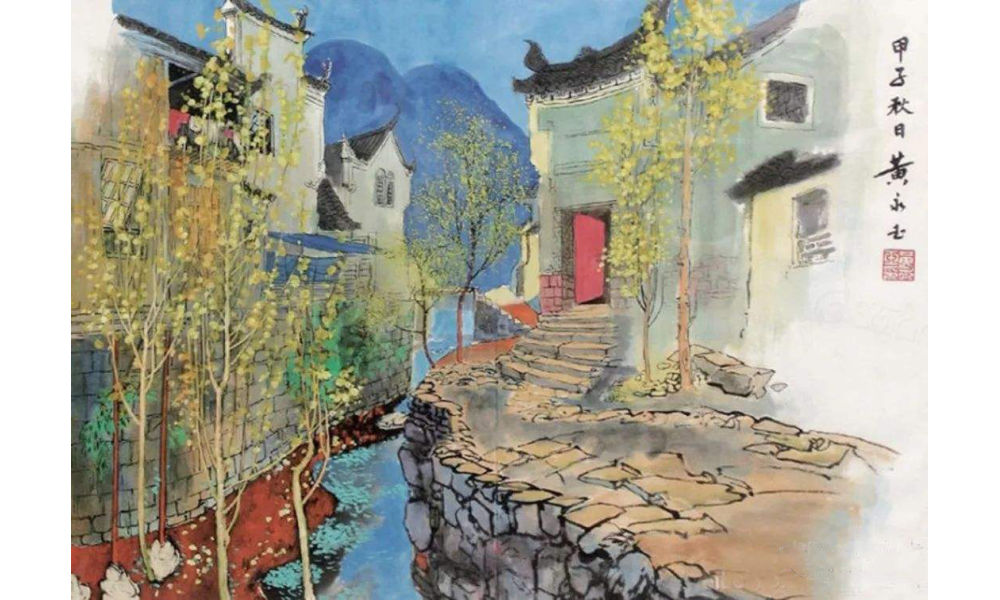
“Hometown Scenery” or rather “Hunan Scenery” (湘西风景) by Huang.
Huang did not dread the end of his life.
“My old friends have all died, I’m the only one left,” he said at the age of 95. He wrote his will early and decided he wanted a memorial service for himself before his final departure. “Quickly come praise me, while I’m still alive,” he said, envisioning himself reclining on a chair in the center of the room, “listening to how everyone applauds me” (CCTV, Sohu).
He stated: “I don’t fear death at all. I always joke that when I die, you should tickle me first and see if I’ll smile” (“对死我是一点也不畏惧,我开玩笑,我等死了之后先胳肢我一下,看我笑不笑”).
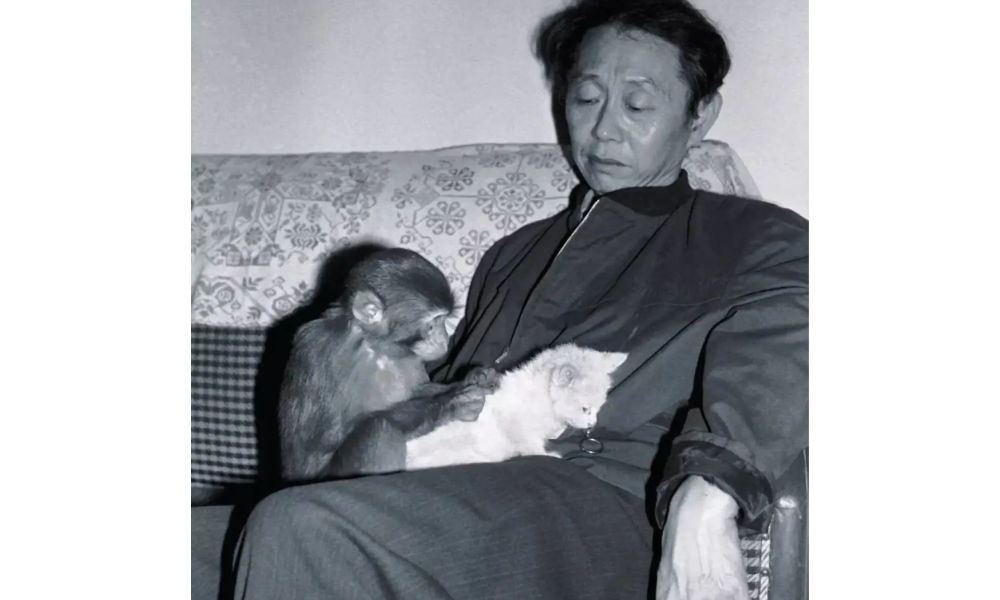
Huang with Yiwo (伊喔), the original model for the monkey stamp [Shanghai Observer].
Huang also was not sentimental about what should happen to his ashes. In a 2019 article in Guangming Daily, it was revealed that he suggested to his wife the idea of pouring his ashes into the toilet and flushing them away with the water.
However, his wife playfully retorted, saying, “No, that won’t do. Your life has been too challenging; you would clog the toilet.”
To this, Huang responded, “Then wrap my ashes into dumplings and let everyone [at the funeral] eat them, so you can tell them, ‘You’ve consumed Huang Yongyu’s ashes!'”
But she also opposed of that idea, saying that they would vomit and curse him forever.
Nevertheless, his wife expressed opposition to this idea, citing concerns that it would cause people to vomit and curse him indefinitely.
In response, Huang declared, “Then let’s forget about my ashes. If you miss me after I’m gone, just look up at the sky and the clouds.” Eventually, his wife would pass away before him, in 2020, at the age of 98, having spent 77 years together with Huang.
Huang will surely be missed. Not just by the loved ones he leaves behind, but also by millions of his fans and admirers in China and beyond.
“We will cherish your memory, Mr. Huang,” one Weibo blogger wrote. Others honor Huang by sharing some of his famous quotes, such as, “Sincerity is more important than skill, which is why birds will always sing better than humans” (“真挚比技巧重要,所以鸟总比人唱得好”).
Among thousands of other comments, another social media user bid farewell to Huang Yongyu: “Our fascinating Master has transcended. He is now a fascinating soul. We will fondly remember you.”
By Manya Koetse
Get the story behind the hashtag. Subscribe to What’s on Weibo here to receive our newsletter and get access to our latest articles:
References
Andrews, Julia Frances. 1994. Painters and Politics in the People’s Republic of China, 1949-1979. Berkley: University of California Press.
Baike. “Huang Yongyu 黄永玉.” Baidu Baike https://baike.baidu.com/item/%E9%BB%84%E6%B0%B8%E7%8E%89/1501951 [June 14, 2023].
CCTV. 2023. “Why Everyone Loves Huang Yongyu [为什么人人都爱黄永玉].” WeChat 央视网 June 14.
Chen Hongbiao 陈洪标. 2019. “Most Spicy Artist: Featured in a Magazine at 80, Flirting with Lin Qingxia at 91, Playing with Cars at 95, Wants Memorial Service While Still Alive [最骚画家:80岁上杂志,91岁撩林青霞,95岁玩车,活着想开追悼会].” Sohu/Guangming Daily March 16: https://www.sohu.com/a/301686701_819105 [June 15, 2023].
Hawks, Shelley Drake. 2017. The Art of Resistance Painting by Candlelight in Mao’s China. Seattle: University of Washington Press.
Matthysen, Mieke. 2021. Ignorance is Bliss: The Chinese Art of Not Knowing. Palgrave Macmillan.
Ora Ora. “HUANG YONGYU 黃永玉.” Ora Ora https://www.ora-ora.com/artists/103-huang-yongyu/ [June 15, 2023].
Spotted a mistake or want to add something? Please let us know in comments below or email us. First-time commenters, please be patient – we will have to manually approve your comment before it appears.
©2023 Whatsonweibo. All rights reserved. Do not reproduce our content without permission – you can contact us at info@whatsonweibo.com.
Subscribe

Chinese New Nickname for Trump Mixes Fairy Tales with Tariff War

China Trending Week 15/16: Gu Ming Viral Collab, Maozi & Meigui Fallout, Datong Post-Engagement Rape Case

China Reacts: 3 Trending Hashtags Shaping the Tariff War Narrative

No Quiet Qingming: From High-Tech Tomb-Sweeping to IShowSpeed & the Seven China Streams

From Trade Crisis to Patriotic Push: Chinese Online Reactions to Trump’s Tariffs

“Dear Li Hua”: The TikTok/Xiaohongshu Honeymoon Explained

Beyond the Box Office: What’s Behind Ne Zha 2’s Success?

15 Years of Weibo: The Evolution of China’s Social Media Giant

Tuning Into the Year of the Snake

IShowSpeed in China: Streaming China’s Stories Well

TikTok Refugees, Xiaohongshu, and the Letters from Li Hua

The ‘China-chic Girl’ Image and the Realities of China’s Competitive Food Delivery Market

US-Russia Rapprochement and “Saint Zelensky”: Chinese Online Reactions to Trump’s Shake-Up

“Black Myth: Wukong”: From Gaming Screens to the CMG Spring Festival Gala?

Collective Grief Over “Big S”
Get in touch
Would you like to become a contributor, or do you have any tips or suggestions? Get in touch here!
Popular Reads
-

 China Insight11 months ago
China Insight11 months agoThe Tragic Story of “Fat Cat”: How a Chinese Gamer’s Suicide Went Viral
-

 China Digital10 months ago
China Digital10 months agoChina’s 2024 Gaokao Triggers Online Discussions on AI
-

 China Arts & Entertainment11 months ago
China Arts & Entertainment11 months agoSinging Competition or Patriotic Fight? Hunan TV’s ‘Singer 2024’ Stirs Nationalistic Sentiments
-
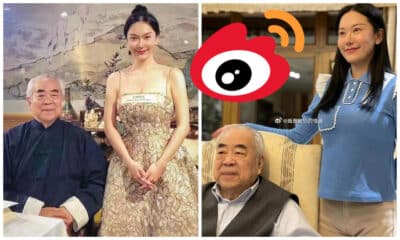
 China Arts & Entertainment12 months ago
China Arts & Entertainment12 months ago“Old Bull Eating Young Grass”: 86-Year-Old Chinese Painter Fan Zeng Marries 36-Year-Old Xu Meng

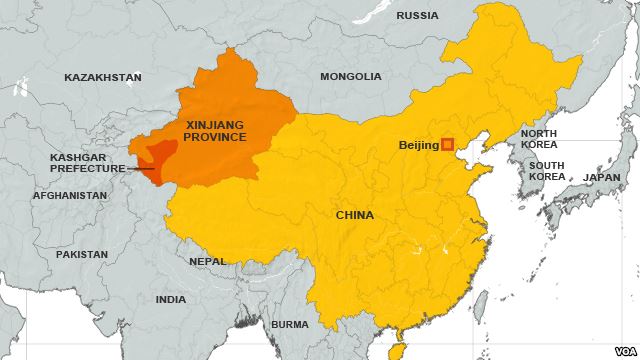
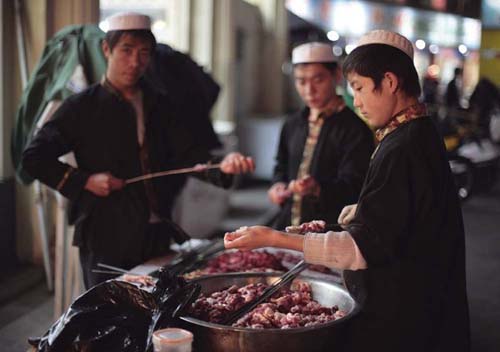
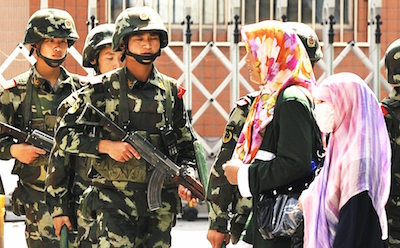


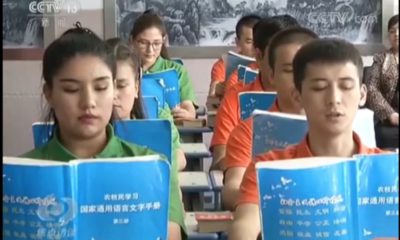

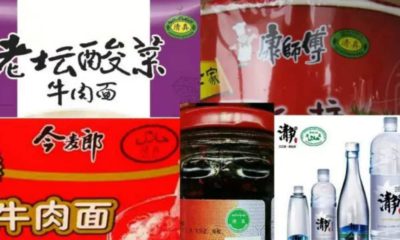


goldie wan kenobi
February 15, 2015 at 5:48 am
Talking with Xinjiang person I learned that she did not consider herself Chinese she said ” I am Chinese when around ethnic Chinese people, and I am myself when they are gone. We don’t feel Chinese and barely look it.” Muslim is not an ethnicity the writer continually referred to these people of Xinjiang as an ethnic group called Muslims. Thats incorrect.
Manya Koetse
February 15, 2015 at 10:30 am
Dear Goldie,
Thanks for this comment, it is interesting and it shows that your Xinjiang acquaintance, although probably nationally Chinese, does not feel ‘Chinese’. About Muslims as an ethnicity, you are right. But the article also does not state that being ‘Muslim’ is an ethnicity. It says that there officially is no such a thing as a ‘Chinese Muslim’, because, within the PRC, Muslims are not defined as a specific category. Chinese citizens are divided into 56 different ‘minzu’ or ethnic groups; a categorization that is separated from religion. Nevertheless, within these minzu, there are ten that take Islam as their faith. This article is about Islam in China, and not specifically about Uyghurs or Hui etc, it therefore speaks about ‘Muslims’, meaning those ethnic minorities within the PRC that take Islam as their faith. The issue of Muslims in China is complex and cannot be oversimplified. Nowhere does the article state that all people in Xinjiang are Muslims, nor that they all belong to the same ethnicity. Regards, Manya
Alec
February 16, 2015 at 1:49 am
In the last paragraph you wrote ‘China’s relations to its Muslim minorities in the northeast has no sign of progress’, did you mean ‘northwest’? 🙂
Manya Koetse
February 17, 2015 at 4:04 pm
You’re right, thanks Alec, adjusted.